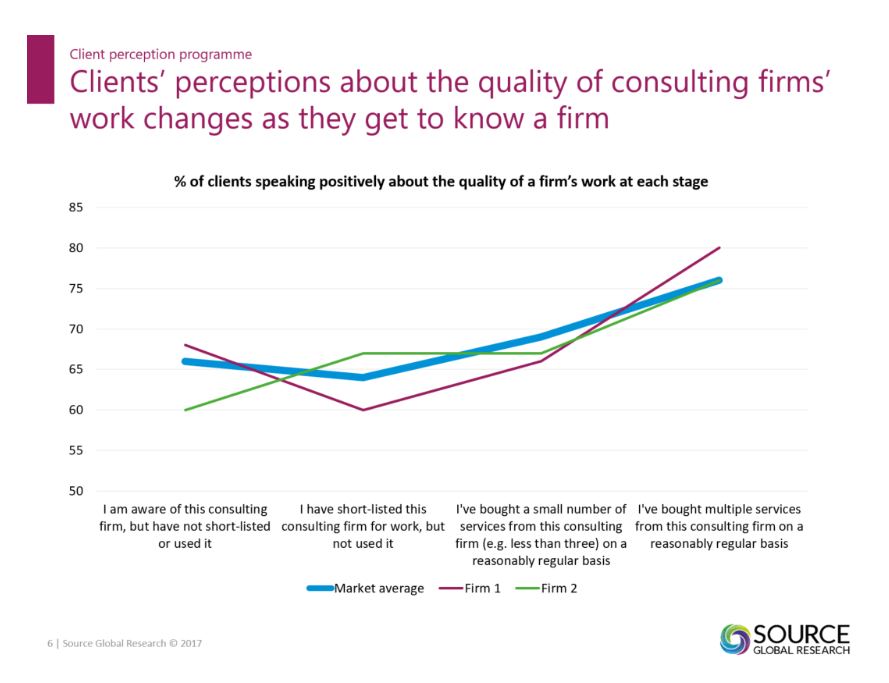Posted , in Featured

You know the feeling: You’ve seen the dress online, or the fancy watch in a shop window. I’ll look so good in it, you think. It’ll be just perfect to wear to that wedding next month, you think. I’ll get compliments from strangers, you think. Life will be better.
But you try it on and it’s not quite right. It’s too big around the middle, the colour isn’t quite right. The oversized watch face makes your wrist look like an udon noodle. You really want it to be the one for you, but after standing there for a few minutes trying to persuade yourself that it’s right, you reluctantly concede that it isn’t.
Clients of consulting firms describe a similar journey with the consulting firms they encounter.

The thick blue line in the chart above shows how the average client’s perceptions about the quality of the average consulting firm’s work changes over time. Sixty-six percent speak positively about quality when they’re simply aware of a firm, but haven’t used it. They may have seen its website, read its thought leadership, or seen consultants from the firm around in their organisation—effectively catching a glimpse of the firm in the shop window.
But then they actually start to entertain the idea of parting with their money (e.g., shortlisting the firm for some work) and that makes them slightly more critical. We might not be talking about something as significant as a dress that’s the wrong colour or a watch that makes your wrist look like an udon noodle here, but something is a little less right than it was before.
For some firms it’s a more serious issue than others. Take the trajectory of firm 1 (a real firm, but one that we’ll keep anonymous) above. It starts out with better-than-average sentiment about the quality of its work when clients are simply aware of it, but dips quite significantly once its been shortlisted. Why? Twenty-seven percent say it needs to show a deeper understanding of their issues.
But for firm 2 (another real firm) it’s different. It starts in a poorer position than firm 1 when prospects are simply aware of it, but improves more than most other firms at the shortlisting stage.
Beady eyes will notice that leaving a strong impression at the shortlisting stage doesn’t necessarily translate into perceptions of high-quality work once a firm is through the door and working with a client. On average, 69% of clients that use a firm for a limited number of services speak positively about the quality of its work—not hugely different from those who are simply aware of a firm. The two firms featured here score below the market average, despite their differing performances at the previous stage, and firm 1 ends up exceeding the market average among its most loyal clients.
It’s the heavy users of consulting firms that speak most positively about their work. Why? It could be a number of things. Most likely, these are clients in a firm’s key accounts—the ones that are most important to revenue generation. This is where firms concentrate their efforts, ensuring they know every nook and cranny of their client’s business. They may have worked with the client for years, building a deep and trusting relationship, and putting their best talent on projects. And maybe a virtuous circle is at work here, too: the more a client buys, the greater opportunity for a firm to show off what it can do and make a bigger impact.
There’s an argument that the opinions of this group matter most, and certainly this feels like a true reflection of client satisfaction and of a firm’s brand impact; I think it’s perhaps a fair reflection of consulting firms at their best. But any given firm’s loyal clients only make up a tiny proportion of the consulting market—just as the dresses I own only make up a tiny proportion of the universe of dresses out there (something I plan to work on). Indeed, in our survey, heavy users of consulting firms make up 14% of the sample. The question I think firms should be asking themselves is: What are we doing to change the minds of the other 86%?
Would you like to hear more about client insights? We’ve recently published a report that reveals the 15 attributes that make up a consulting firm’s DNA. You can download your free copy here.